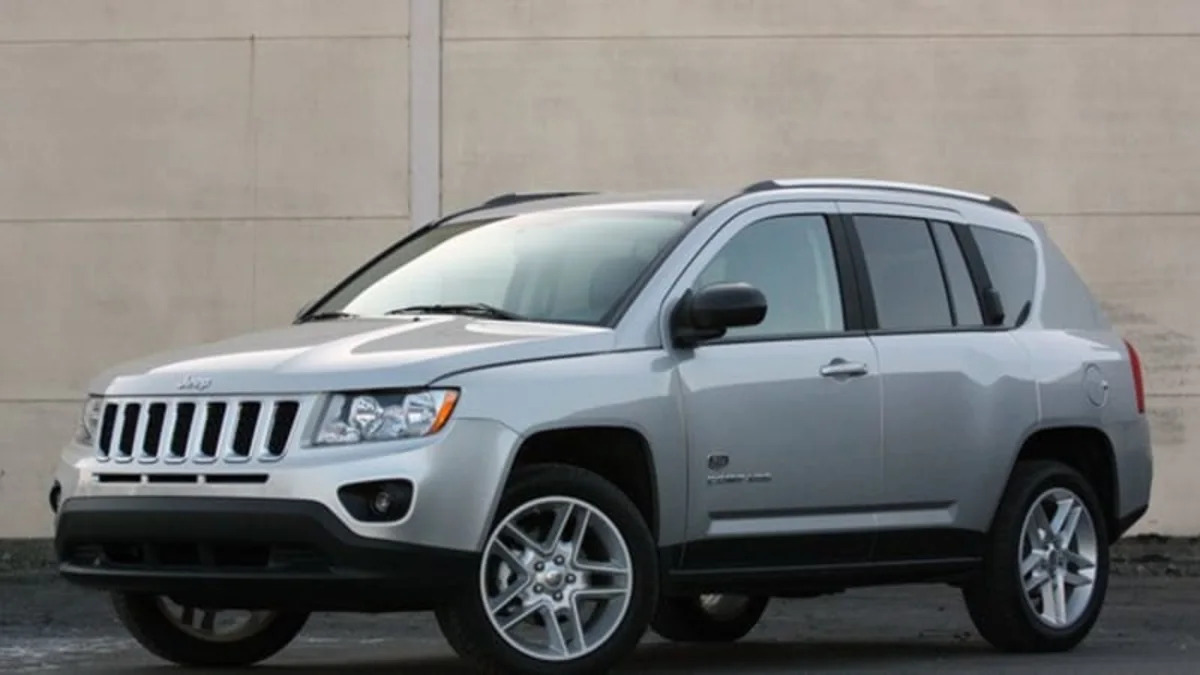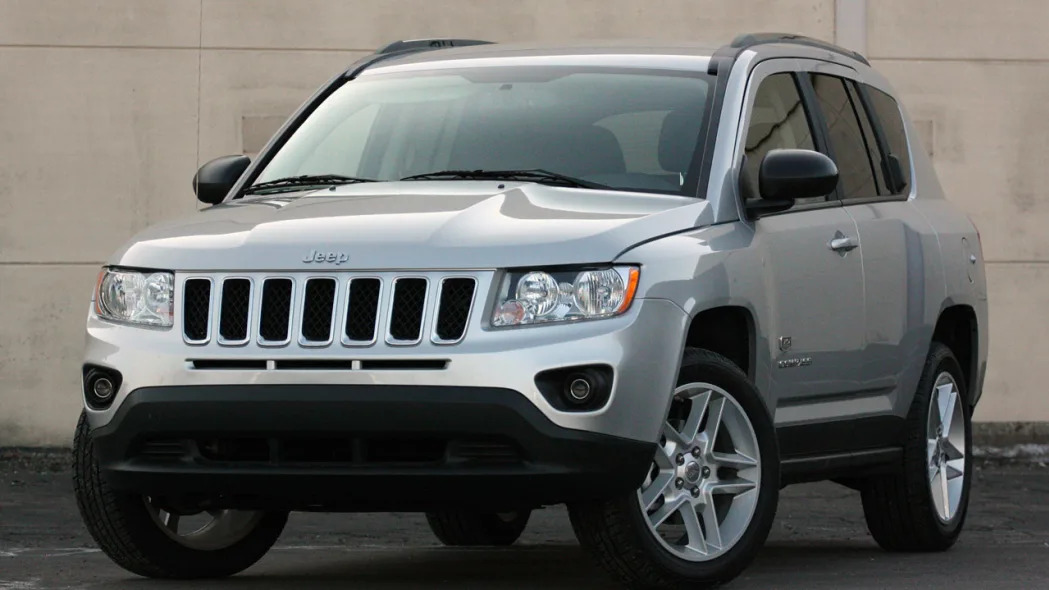Least Capable Jeep Still Lost In The Woods
Let's be honest here: The Jeep Compass should have never been built – at least not in the form it took. A derivative of the compact Dodge Caliber, the Compass is neither a real Jeep nor an SUV, but a singular testament to how badly Daimler mismanaged the brand over its decade of ownership. And sales have proven this out. Although the Compass did well in the first year after its May 2006 launch, interest quickly cooled, and through the end of 2010, Chrysler had totaled only 111,000 Compass sales. The company managed to move fewer than 16,000 of them last year.
A "softroader," the Compass was meant to compete in the growing field of compact, front-wheel-drive crossovers often derided as "Cute Utes." The misguided, condescending and paternalistic attitude of the Germans running DaimlerChrysler at the time was that young women would flock to the Compass, while its mechanical twin, the Jeep Patriot, was designed for the boys. While the Patriot at least looked like a Jeep – the much-loved, discontinued Cherokee – the googly-eyed Compass was cartoonish, like a Jeep animated for the Powerpuff Girls.
Continue reading Review: 2011 Jeep Compass...
2011 Jeep Compass - Click above for high-res image gallery
Let's be honest here: The Jeep Compass should have never been built – at least not in the form it took. A derivative of the compact Dodge Caliber, the Compass is neither a real Jeep nor an SUV, but a singular testament to how badly Daimler mismanaged the brand over its decade of ownership. And sales have proven this out. Although the Compass did well in the first year after its May 2006 launch, interest quickly cooled, and through the end of 2010, Chrysler had totaled only 111,000 Compass sales. The company managed to move fewer than 16,000 of them last year.
A "softroader," the Compass was meant to compete in the growing field of compact, front-wheel-drive crossovers often derided as "Cute Utes." The misguided, condescending and paternalistic attitude of the Germans running DaimlerChrysler at the time was that young women would flock to the Compass, while its mechanical twin, the Jeep Patriot, was designed for the boys. While the Patriot at least looked like a Jeep – the much-loved, discontinued Cherokee – the googly-eyed Compass was cartoonish, like a Jeep animated for the Powerpuff Girls.
Continue reading Review: 2011 Jeep Compass...
Photos copyright ©2011 Steven J. Ewing / AOL
Since its launch, the Compass has been called out for a host of shortcomings, starting with its cheap and noisy interior. While Chrysler revamped the instrument and door panels, along with adding some sound dampening in 2009, the 'ute has finally received a more thorough overhaul for the 2011 model year, with some additional upgrades including a new steering wheel, a new front fascia and grille with a revised hood to match, along with a new four-wheel-drive package that confers a "Trail Rated" label to this least illustrious Jeep.
Nobody can argue against these moves hugely improving the 2011 Compass, but after spending a week with the vehicle, we find that the changes have done little to move the needle against the competition – especially considering Chrysler continues to raise the model's price.
For 2011, the base Compass starts at $19,295, some $4,000 more than Jeep was asking at introduction. At the top of the range, the Compass Limited 4x4 has experienced a similar price creep and is now wearing a $25,995 sticker, up $860 from last year. Our test model, in mid-range "Latitude" trim with the new "Freedom Drive II" off-road package, carried a shocking $27,485 window sticker. That's more expensive than a similarly equipped Liberty – a real rock-crawling Jeep.
Even more galling than our Compass tester's sticker price, however, was its fuel economy panel. The normally reasonable highway mileage, which can even hit 29 mpg in front-drive configuration with a five-speed manual and the smaller 2.0-liter engine, drops to just 23 mpg in the "Trail Rated" Compass models. Chalk this up to a ride height that's been raised by an inch, some extra weight in the form of skid plates and tow hooks, and a different version of the Compass' continuously variable transmission that offers a "low range" for off-roading.
We will take Chrysler's word that this new kit gives the Compass capabilities for "moderate off-road situations that include steep grades, occasional wheel lift and rock or log climbing," as we didn't head off-pavement. Realistically, nobody is ever going to buy one of these for off-roading, just as you'll never see a Compass sporting an "It's a Jeep Thing – You Wouldn't Understand" bumper sticker. Belatedly offering an off-road version of the Compass might begin to address the model's underlying credibility problem, but it's not going to make anybody want to drive one.
We do imagine quite a few prospective buyers will be lured in by the model's new face, as it makes a world of difference in helping it look like a real Jeep – the aforementioned Grand Cherokee, in particular. And naturally, this is by design. For proof, check out the Compass "Bloodlines" marketing campaign below that directly associates the two. Chrysler did an excellent job of restyling the hood as well, and the combined result renders the Compass as an entirely new vehicle. While the rest of the exterior didn't see much change, the new, serious personality imparted by the front-end makeover helps even the strange and blind-spot-inducing D-pillar look more normal.
Unfortunately, for as well as the new styling works, Chrysler hasn't throw an equivalent number of mechanical upgrades into the mix. The Compass does have some revised suspension bits designed to improve its road manners – and it rides and handles about as well as any other compact crossover – but this was never the biggest problem with the Compass. Its noisy and underperforming powertrain was – and still is – the deal-breaker.
Four-wheel-drive Compass models are only available with a 2.4-liter four-cylinder engine making 172 horsepower and 165 pound-feet of torque. In our Compass, this was paired with the disappointing continuously variable transmission, which had us wishing for the standard-equipment manual gearbox. Jeep also offers a 2.0-liter four-cylinder on front-drive models, but with only 158 hp and 141 lb-ft of torque, it promises to feel at least as underpowered as the larger engine. While getting the Compass moving is not the problem – its throttle response and initial acceleration is decent enough – once you hit highway speeds (greater than 45 mph), the vehicle is painfully slow to respond. Even when the CVT pegs the tachometer, you'll experience more volume than motion.
Despite the lack of refinement under its hood, the Compass could still be an endearing choice when shopped against other compact crossovers – until you crunch the numbers on size. This area is paramount among shoppers in the segment, most of which are looking for that magical combination of roominess, cargo capacity, big mpg numbers and low MSRP. Among the price-competitive set – which includes the Honda CR-V, Hyundai Tucson, Nissan Rogue, Toyota RAV4, and Subaru Forester – the Compass is just too small to make up for its shortcomings. Save for rear legroom, the Compass trails in the important measurements of roominess, and its rear cargo capacity is the lowest by a healthy three cubic feet. The class of this class – the CR-V and Subaru Forester – offer over 10 cubic feet more cargo capacity behind their rear seats.
If the new, refreshed Compass were priced more realistically – which will no doubt happen when Chrysler starts putting big cash on the hood – it might make sense as a cheaper, less enticing alternative to its bigger and better competitors. This was part of Chrysler's game plan back when the $15,000 Compass debuted. But as much as that tactic to help move some more metal might again work, there's another idea that seems even better. It has been reported that the Compass is scheduled to be replaced by a new model born from a Fiat platform as early as next year. That's likely the Compass' most promising direction yet.
Photos copyright ©2011 Steven J. Ewing / AOL



Sign in to post
Please sign in to leave a comment.
Continue